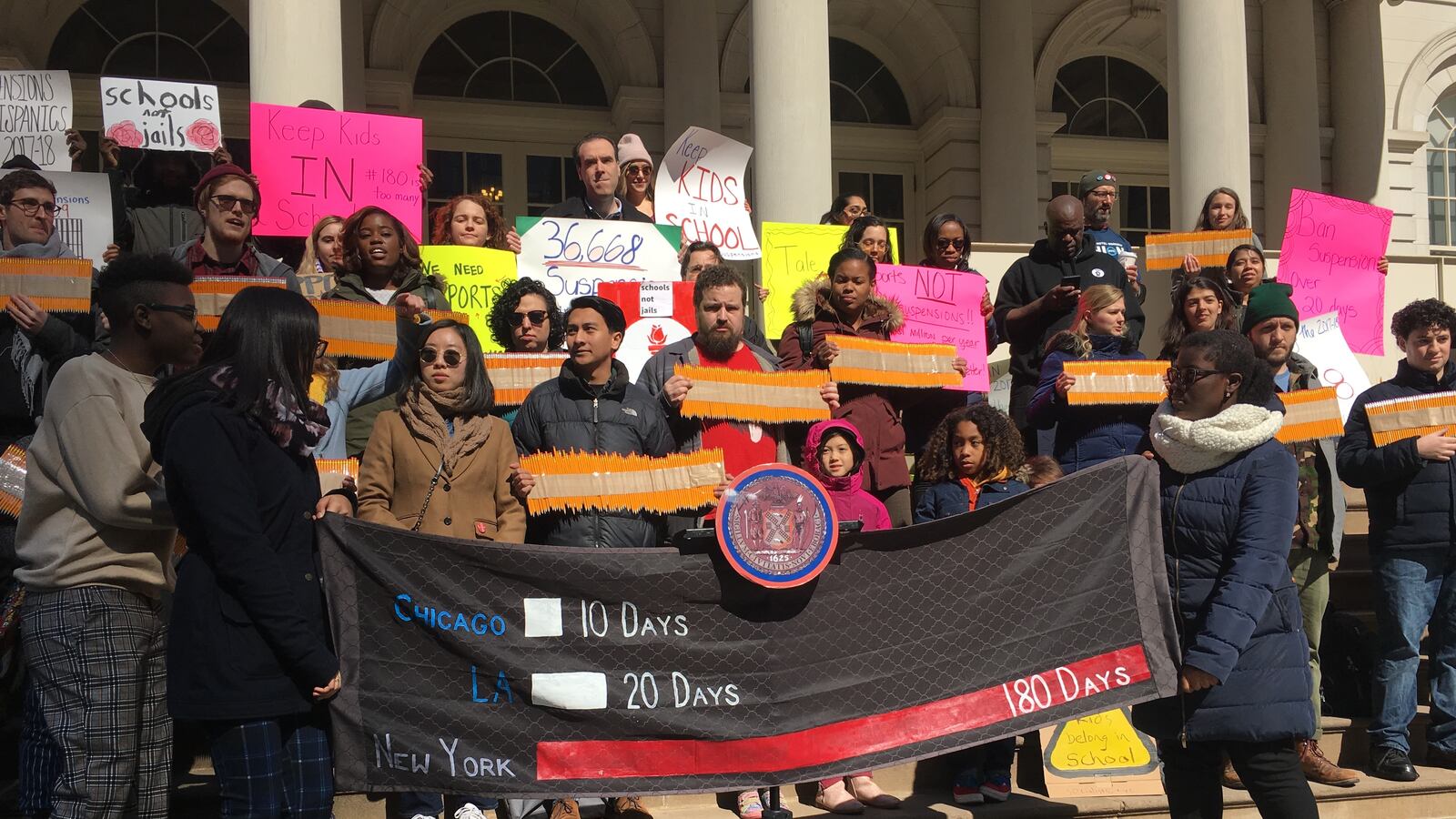When David Altman learned a student was suspended for 30 days recently for allegedly throwing a chair at a school safety agent, he was surprised.
In the past, those types of incidents would have earned students months out of school. But Altman, a law student who helps run New York University’s Suspension Representation Project, said the length of suspensions for a range of behaviors has fallen noticeably.
“It just feels very tight around the 10-20 day [suspensions] right now,” Altman said.
Data obtained by Chalkbeat backs up what Altman and other advocates say they are seeing: that New York City officials have quietly dialed back the length of student suspensions this school year following uproar over suspensions that can stretch up to an entire year.
From July to December 2018, the average length of student suspensions fell from 8.3 to 5.8 days — a 30 percent reduction — compared with the same period in 2017. In recent months, several advocates said they have seen a consistent pattern of shorter suspensions.
Some of the biggest reductions in length came from shorter superintendent suspensions, which are issued for more serious misbehavior. Overall, the average length of superintendent suspensions plummeted to 13.4 days, down from 21.4 during the first half of this school year — a 37 percent decline from the same period last year.
The decline in length of superintendent suspensions was slightly more pronounced for black students — a 40 percent drop to 13.7 days. For Hispanic students, superintendent suspensions were 32 percent shorter on average, according to city data.
The reduction comes as advocates have pressed the issue in recent months and top officials — including the mayor and schools chancellor — have acknowledged concerns about lengthy punishments and said they are reviewing the city’s discipline policies.
[Suspensions drop 14 percent in New York City after a spike last school year]
In New York City, superintendent suspensions are reserved for more serious infractions, ranging from small fights to bringing a weapon to school, and can be issued from six days up until an entire school year. While only 12 students were suspended for 180 days last year, those suspensions in particular have raised eyebrows.
Students who receive any length of superintendent suspensions have the right to a formal hearing and are sent to one of the city’s “Alternative Learning Centers” where they are supposed to continue their studies. Last academic year, more than 10,000 of these suspensions were issued; about a quarter of them were for 30 days or more.
Officials said they have shortened suspensions by looking more closely at the average time students are suspended for a given infraction and distributing that information to the officers who preside over suspension hearings.
For the first time this school year, department officials are reviewing decisions if they seem out of step with the average range, according to LaShawn Robinson, deputy chancellor for school climate and wellness.
“If for some reason we’re finding a hearing officer or an early resolution counselor wants to give something that’s significantly higher than the average, then that’s where [we’re] weighing in,” Robinson said. She added that longer suspensions than average may still be issued in some cases.
Those changes appeared to be trickling down to individual student suspension hearings, advocates said.
“We’ve seen a decrease in the length of suspensions across the board,” said Cara Chambers, the director of the Legal Aid Society’s education advocacy project. “The dispositions that are coming out of the suspension offices are markedly different.”
Discipline reform advocates have pushed the education department to reduce the length of superintendent suspensions, which are more likely to be issued to students of color. One analysis found that black students are more likely to receive harsher suspensions for the same infractions committed by their peers in other racial groups. Some research, focused on New York City, has shown suspensions contribute to negative academic outcomes.
Schools Chancellor Richard Carranza has said he is reviewing the city’s discipline code, essentially the manual that governs how educators respond to student misbehavior, and which leaves wide discretion over how long students are suspended. Meanwhile, state lawmakers have reintroduced legislation that would cap suspensions at 20 days.
Previous efforts to overhaul the city’s discipline code have proved controversial. Officials have made it harder to suspend students for certain infractions in recent years and some educators and union officials have resisted changes that limit their authority, saying it contributes to more chaotic classrooms.
While the city has made efforts to train educators on “restorative” approaches — where educators work to troubleshoot misbehavior and work with students to improve instead of issuing punitive punishments — critics argue there hasn’t been sufficient training and those efforts have not reached enough schools.
Asked about those concerns, Robinson said the city is committed to expanding training for educators. “One hundred percent we must provide educators with the supports they need to do this work,” she said.
Kesi Foster, a discipline reform advocate with Make the Road New York, said the reduction in suspension length is an encouraging sign, but wished there was a more public process and discussion about the city’s strategy.
“If the administration is making changes that are reducing the length of suspensions, that is an important step,” he said. “It’s important for them to engage stakeholders about the changes that they’re making.”

